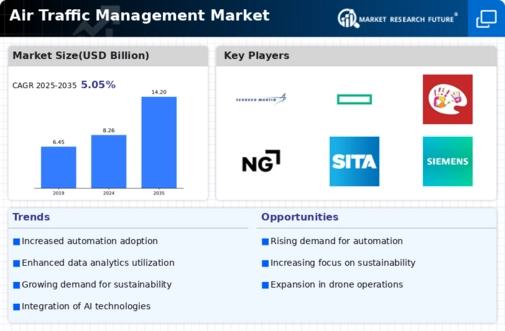Top Industry Leaders in the Air Traffic Management Market

Key Players
FrequentisComsoft GmbH (Germany)
BAE Systems (UK)
Saab AB (Sweden)
Honeywell International Inc. (US)
Northrop Grumman Corporation (US)
Harris Corporation (US)
Indra Sistemas, SA (Spain)
Raytheon Company (US)
Thales Group (France)
ANPC (US)
Strategies Adopted
In the race for airspace dominance, key players in the ATM market adopt diverse strategies to secure their positions. Technological innovation stands out as a central strategy, with companies investing heavily in the development of next-generation ATM systems. Thales, for instance, focuses on artificial intelligence (AI) and machine learning to optimize air traffic flow and enhance predictive analytics, thereby reducing congestion and delays.
Collaboration and partnerships are also key strategies, as seen in joint ventures between major players and air navigation service providers (ANSPs). Lockheed Martin's partnerships with ANSPs globally highlight the importance of collaboration in delivering comprehensive ATM solutions. Additionally, customization and flexibility in offerings are prioritized, allowing companies to tailor solutions to the unique needs of different regions and airspace structures.
Factors for Market Share Analysis
Several factors contribute to the analysis of market share within the ATM sector. First and foremost is the technological capability and reliability of the solutions offered. Companies that provide cutting-edge technologies, such as advanced surveillance systems and automation tools, tend to capture a larger market share. Thales' TopSky-ATC, a widely adopted air traffic control system, exemplifies the significance of technological prowess.
Global reach and market penetration are also critical determinants. Companies with a broad international presence and established partnerships with aviation authorities are better positioned to secure a larger market share. Understanding and compliance with evolving regulatory standards, such as those set by the International Civil Aviation Organization (ICAO), are essential for maintaining credibility and gaining market share in an industry where safety and compliance are paramount.
The ability to provide holistic solutions that cover the entire spectrum of air traffic management, including communication, navigation, surveillance, and automation, is another factor influencing market share. Companies offering comprehensive, integrated solutions can address the complex challenges of modern airspace management more effectively, consolidating their positions in the market.
New and Emerging Companies
The ATM market is witnessing the emergence of new players, often bringing disruptive technologies and innovative solutions to the forefront. Aireon, a prime example, has introduced space-based ADS-B (Automatic Dependent Surveillance-Broadcast) technology, providing global air traffic surveillance coverage. These emerging companies challenge established norms and contribute to the transformation of traditional air traffic management.
Start-ups focusing on drone traffic management also represent a growing segment within the ATM landscape. Companies like AirMap and Unifly offer solutions for managing the increasing complexity of integrating drones into controlled airspace, addressing a burgeoning need as unmanned aerial vehicles become more prevalent.
Industry News
Staying informed about industry news is imperative for understanding the competitive dynamics within the ATM market. Recent developments include the increasing emphasis on digitalization and the adoption of remote tower technologies. The COVID-19 pandemic has accelerated the deployment of remote towers, allowing air traffic controllers to manage multiple airports from a centralized location, enhancing operational efficiency and reducing costs.
Furthermore, the integration of artificial intelligence and machine learning algorithms for predictive analytics and decision support tools has become a focal point. These advancements aim to optimize air traffic flows, improve fuel efficiency, and enhance overall airspace management.
The ongoing deployment of satellite-based communication and navigation systems, such as the Next Generation Air Transportation System (NextGen) in the United States and the Single European Sky ATM Research (SESAR) in Europe, are transforming traditional ATM paradigms. Keeping abreast of these developments is crucial for companies seeking to adapt and innovate in an ever-evolving industry landscape.
Current Company Investment Trends
Investment trends within the ATM market reflect the industry's response to the demand for more efficient, safe, and sustainable airspace management. Companies are allocating significant resources to research and development, with a focus on technologies like AI, machine learning, and blockchain for enhancing data security and integrity. Additionally, investments in cybersecurity are gaining prominence to safeguard critical ATM infrastructure against potential threats.
Sustainable and eco-friendly solutions are also driving investments, aligning with broader industry trends toward environmental responsibility. Companies are exploring ways to reduce carbon emissions and improve overall environmental sustainability in line with global aviation goals.
Overall Competitive Scenario
The competitive landscape of the Air Traffic Management market is characterized by a blend of established industry leaders and innovative newcomers, all vying for supremacy in a rapidly evolving industry. Key players adopt strategies centered around technological innovation, collaboration, and customization to maintain and enhance their market positions. Market share analysis factors include technological capability, global reach, regulatory compliance, and the ability to provide holistic solutions.
New and emerging companies contribute to the industry's transformation, introducing disruptive technologies and addressing evolving challenges. Industry news highlights the ongoing digitalization, remote tower technologies, and the integration of AI, shaping the future of air traffic management. Current investment trends underscore the industry's commitment to innovation, sustainability, and the continuous pursuit of safer and more efficient airspace management.
As the Air Traffic Management market continues to soar to new heights, companies that can navigate these challenges, embrace innovation, and foster collaborations are poised to lead the way in shaping the future of airspace management
Recent News
Raytheon Technologies Corporation (RTX)
Developed a next-generation digital tower system incorporating artificial intelligence and advanced automation capabilities for enhanced situational awareness and decision-making.
Collaborated with airlines and air navigation service providers on trials for advanced route optimization technologies, aiming to reduce fuel consumption and emissions.
Indra Sistemas, S.A. (IDR)
Launched a new air traffic management platform featuring advanced weather prediction and collaborative decision-making tools, improving safety and flight efficiency.
Secured a contract with a European air navigation service provider to implement their enhanced surveillance system for more precise aircraft tracking.


